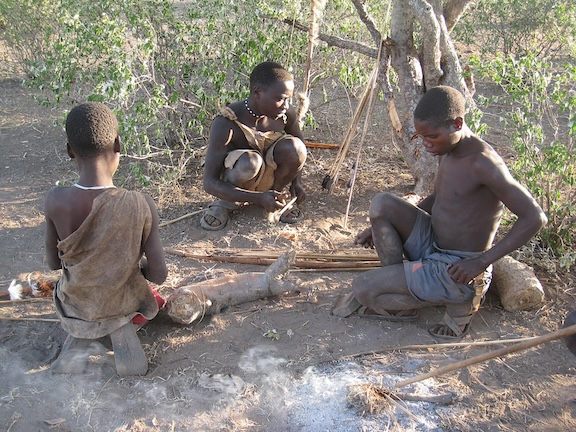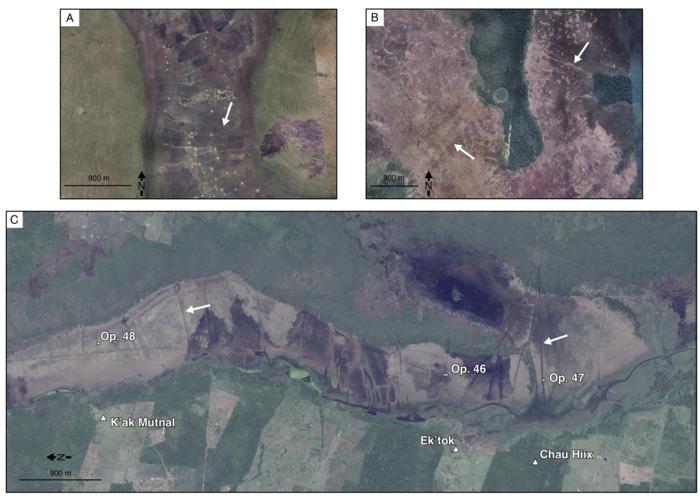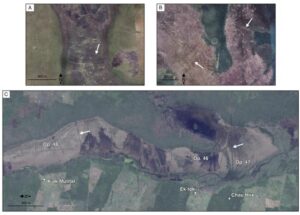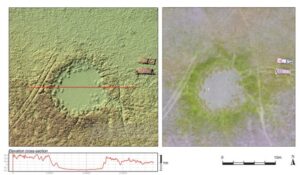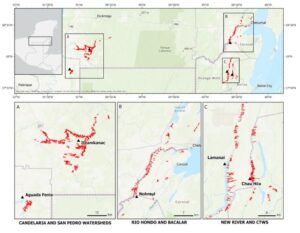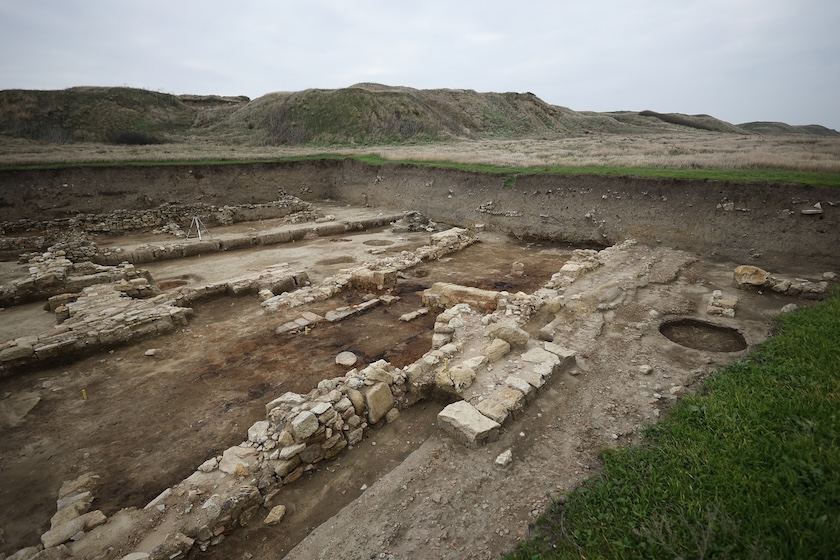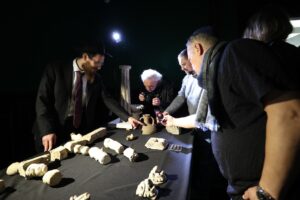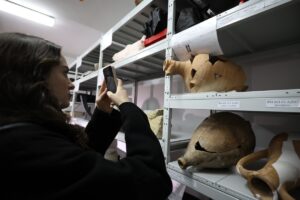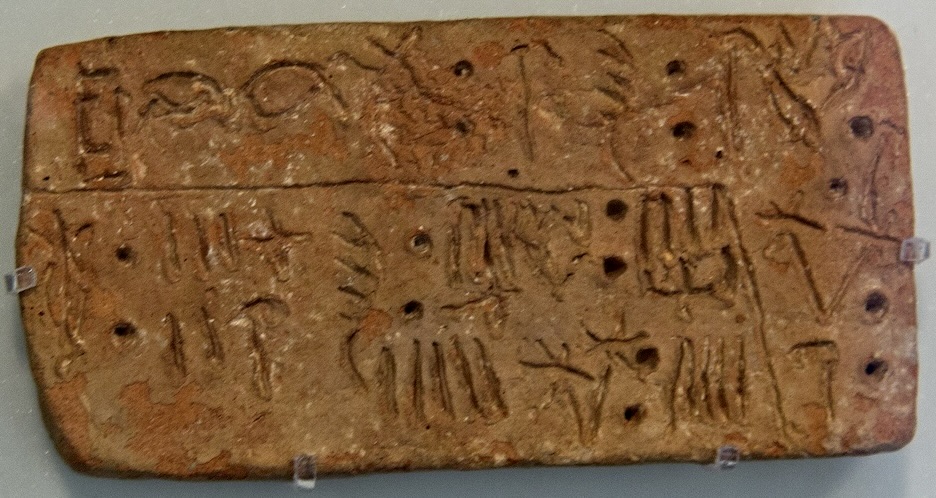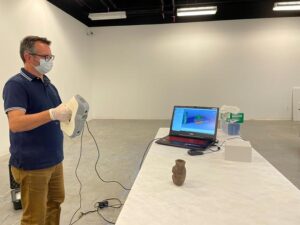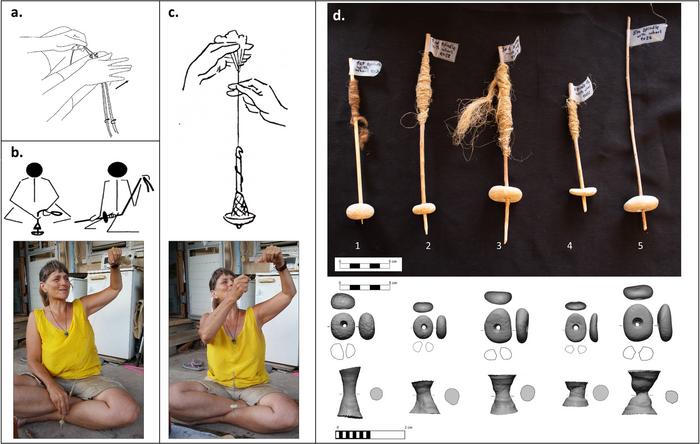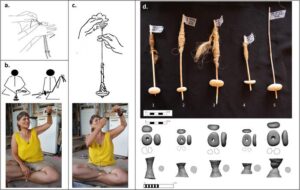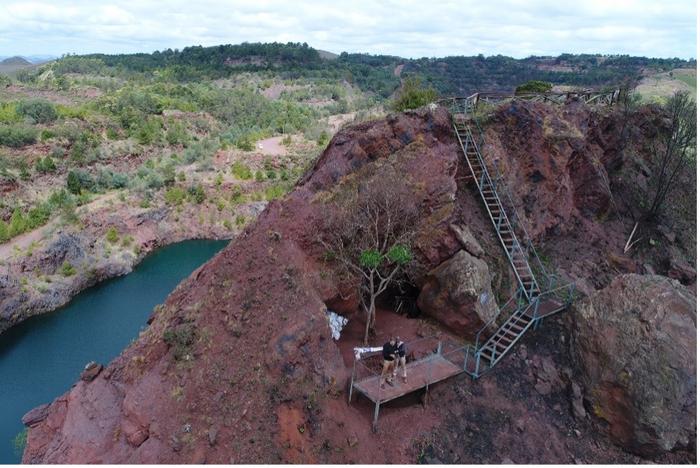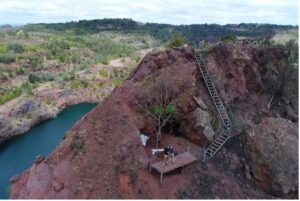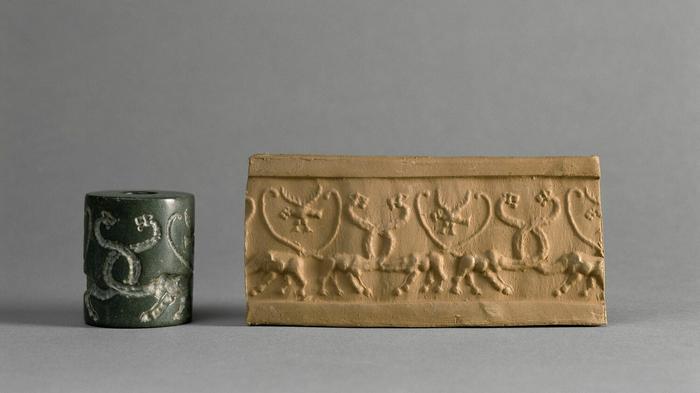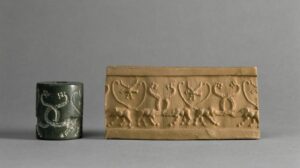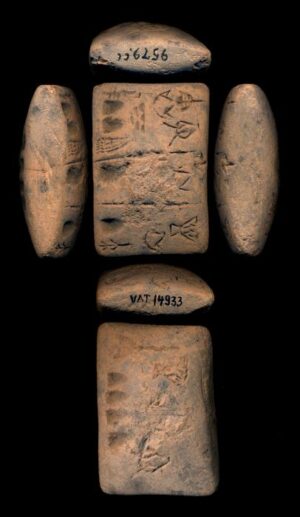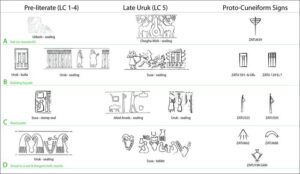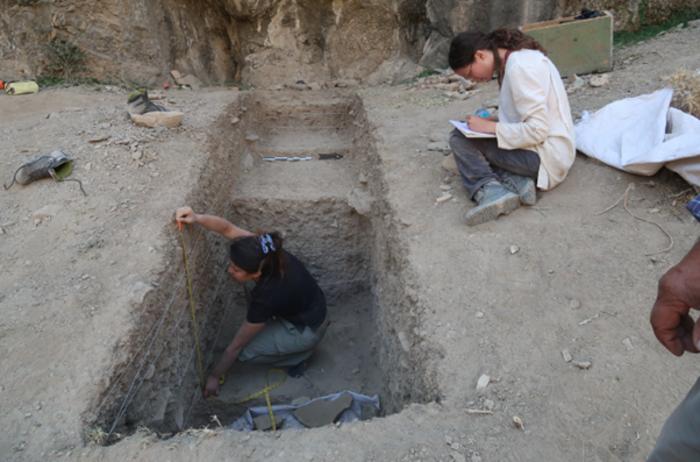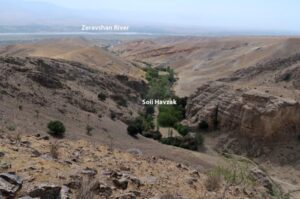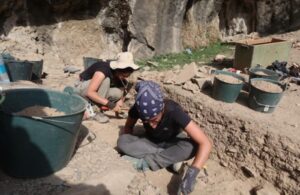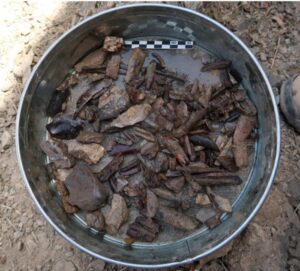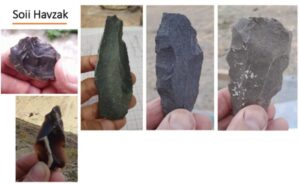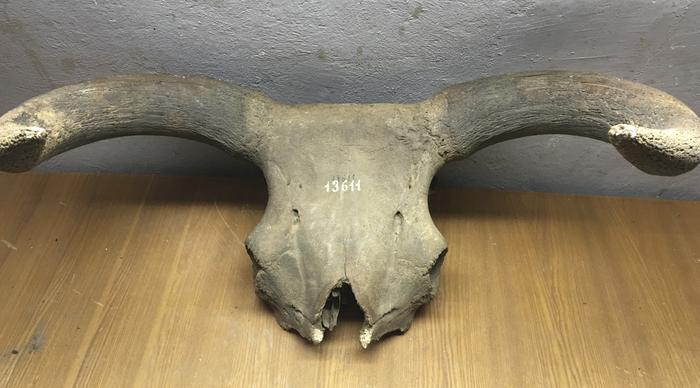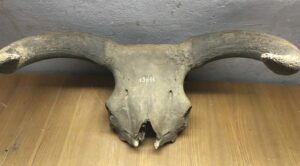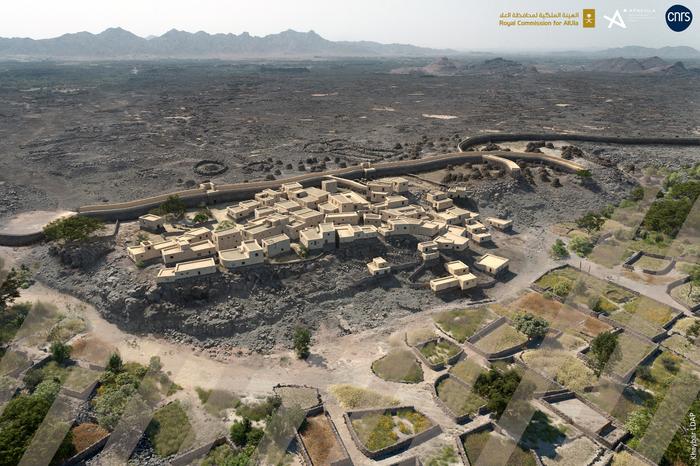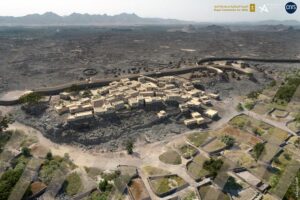
“I will endure to be burned, to be bound, to be beaten, and to be killed by the sword.”–Gladiator’s Oath (Petronius, Satyricon 117).
For many of us, the gladiatorial games of ancient Rome represent both a fascinating and puzzling world of contradictions. Those who take up the sword, gladiators, are cursed as infames; like prostitutes, actors, criminals, they are viewed as non-citizens, and yet they rise to the level of ancient ‘rock-star’, praised and cheered by thousands in the arena. Spanning nearly 6oo years (from the third century B.C. into the fifth century A.D.), and three continents, gladiator contests were brutal and often bloody spectacles. Extremely popular in their day, they played a significant role in the public life and identity of its citizens. While our modern perception of these ancient spectacles, however, often calls to mind massive amphitheaters teeming with thousands of screaming fans, gladiatorial combat had humble beginnings. Like chariot racing and animal hunts, gladiatorial contests began as more quasi-religious, intimate displays of munera, or duty to the ancestors. More than simply a spectacle, the games were institutionalized forms of human sacrifice that served to ease the passing of the deceased, as well as help cure the surrounding community of evil spirits of the dead. Though marginalized in Roman society, the blood of gladiators often served an important role in cult rituals, as well as providing cures for the disease.
Origins
Historically, scholars have remained divided about the specific nature and origins of gladiatorial games. Some claim that they had their beginnings in ancient Etruria, based on both historical and art historical evidence. The historian Nicolaus of Damascus, writing in the age of Augustus, claimed that the Romans had inherited the games from the Etruscans. Additionally, frescoes from Etruria highlight gladiatorial-like combat. The famous 6th-5th century wall painting from the Tomb of the Augurs in Tarquinia highlights a pair of wrestlers accompanied by the figure of a priest, seen holding his telltale lituus, a sign of his office, suggesting a religious context to the ritual. At their feet appears a series of libation bowls possibly used for harvesting blood. Next to them we find the masked figure of the phersu, holding the leash of a dog that is attacking a man dressed in a loincloth. The victim’s wrists are bound, and his head is covered with a sack. The scene has several interpretations: it is either thought to represent a precursor for the venationes, (or “animal games,” an athletic event) or a sacrifice again meant to appease the ancestors as part of an Etruscan funeral rite (Welch, 2007: 15). As Alison Futrell notes, “men fought to the death at the funeral of a much-beloved leader, whose spirit benefitted from the spilling of blood” (Futrell, 2006: 6). Other themes of blood sacrifice appear in mythological contexts, such as those depicted in François Tomb at Vulci, with Achilles sacrificing Trojan prisoners (Jannot, 2005:16) in order to appease the spirit of his beloved Patroclus.
Similar arguments for an Osco-Samnite origin have been made based again on strong textual and archaeological evidence (Ville 1969: 116). Livy relates “the Campanians on account of their arrogance and their hatred of the Samnites armed their gladiators, who performed during banquets, in the fashion [of the captured men] and addressed them as ‘Samnites’” (Ab Urbe Condita, 9.40.17). A 4th century B.C. tomb fresco from Paestum shows men equipped with shields and spears, sporting loin cloths and helmets squaring off. Streaks of blood seem to suggest a real-time duel. Other tombs in Paestum, such as Tomb X from the Laghetto Necropolis, carry scenes of chariot races along with hand-to-hand combat between armed warriors. In either case, the original function of gladiatorial contests seems to be rooted in ritual blood sacrifice to a fallen war hero, whether realized (actual death), or idealized (having one gladiator surrender to another).
The Games Come to Rome
The first gladiatorial games, according to Livy, were performed in Rome in 264 B.C. to honor the funerary celebrations for Iunius Brutus. Two gladiators were paired to the death in the Forum Boarium, the old cattle market. Here, it is important to note that Livy uses the Latin word munus, the first historical instance of a duty to the dead. While we can only conjecture as to the nature of ancient combat as a form of ritual violence meant to appease the dead in Etruscan and Osco-Samnite cultures, here we have a definite Latin word used to describe the ritual. The Roman writer Ausonius reports that three pairs were selected of the Thracian type, while Servius adds that some had been captured in battle, prisoners of war. In 216 B.C., the sons of Marcus Aemelius Lepidus, consul in 232 B.C., effectively raised the bar by hosting twenty-two pairs of gladiators for seven days in the Forum (Livy, Ab Urbe 23.30.15). The funeral of Publius Licinius saw that number increase nearly five fold with 120 gladiators (Livy, Ab Urbe 39.42.2) in 183 B.C. In 174 B.C., 74 gladiators fought for four days in honor of Titus Flaminius (Livy, Ab Urbe 41.28.11). Within the short span of a hundred years, as the need for Roman elites to compete for familial gloria increased, so did the exposure and popularity of the games.
________________________________________
_______________________________
Roman Views of Ritual Sacrifice
For the most part, the Romans found the idea of human sacrifice abhorrent, a ritual practiced only by barbarians and frequently by their enemies. Quintus Curtius records the Carthaginians engaging in child sacrifice, treating it as more sacrilege than sacred (Historiae Alexandri Magni 4.3). Likewise, Cicero mentions that the altars of the Gauls are defiled with human sacrifice (Pro M. Fonteio 32). However, while the Romans explicitly condemned it, history has shown that they often resorted to it, but only in times of great public stress or turmoil. The Vestal priestess Oppia was buried alive for breaking her vow of chastity according to Livy (Ab Urbe 2.42), but only after an outbreak of war. During the Punic Wars, after the humiliating defeat at Cannae, the Romans sacrificed two pairs of men and women, from Gaul and Greece, burying them alive under the Forum Boarium (Ab Urbe 22.57). Even as late as imperial Rome, though officially banned in 97 B.C., Pliny records that human sacrifice had been carried out in the Forum Boarium by the Quindecimviri, with no imminent disaster at hand. He, however, stresses the status of the sacrificed men as belonging to groups that were hostile to Rome (Nat. Hist. 28.3).
Such inconsistencies did not escape the notice of ancient historians. Plutarch questioned the nature of Roman sacrificial rituals, whether they were meant to appease the spirits of the dead (manes) or the gods. While appearing as though a double standard, it should be stressed that Roman ritual sacrifice depended on a number of important factors: the ritual, the current socio-economic conditions, and the social rank of the victims. At first, we may observe that the Romans carried out such sacrifices during times of great stress, or when the community was plagued by bad omens. In the case of the priestess Oppia, by breaking her vows, she had committed a social taboo, which was punishable in its own right. The outbreak of war with Veii must have confirmed the transgression, thus her sacrifice was needed in order to restore balance, and for the community to be healed. The sacrifice of the Greeks and Gauls, traditional enemies of Rome, seems particularly apropos. Most likely slaves or prisoners of war, they were sacrificed in order to appease the spirits of the dead, and heal the community from the taint of death and bad omens. What is crucial to understanding the justification of human sacrifice is that most victims were non-Romans, and they were buried alive on unholy ground rather than experiencing proper Roman burials.
Gladiator Blood
Gladiators, like our example above, were also outsiders, often prisoners of war, slaves, or criminals stripped of their Roman citizenship. They were essentially non-Romans, and as such they became subject to human sacrifice; yet they held a special status, because they were marked for death and met it head on. Though some scholars might argue that gladiatorial games were not seen as a form of ritual sacrifice to the Romans (e.g, Vittese 2008: 87; Wiedemann, 1992: 23), I would contend that there is ample evidence to suggest that gladiators fulfilled the role of pharmakos, the traditional scapegoat sacrificed in order to help cure an outbreak of bad omens, or sickness within a city. The physician Aulus Cornelius Celsus, for example, in discussing comitialis, or epilepsy, claims that the blood from a freshly slain gladiator can cure the condition: “Some have freed themselves from such a disease by drinking the hot blood from the cut throat of a gladiator” (de Med. 3.23.7). The practice is also recorded by Pliny the Elder, who adds that though an impious act which one would not even do with animal blood, those who drink the warm blood of the gladiator felt as though they were drawing forth the life of the dying man himself (28.2). More than simply blood lust or a case of Roman vampirism, the act of drinking the blood has both a physical and spiritual advantage. Spiritually, for those thinking it was an attack from vengeful spirits, the blood would help propitiate them. Physically, the warmth of the blood, as both Pliny and Celsus observe, would have restored the balance of ‘warm’ to ‘cold blood’ built up in the patient’s body. The Greek physician Hipprocrates noted that epilepsy was not brought on by the divine, but was caused by the body itself, specifically cold phlegm forming in or on the heart, thereby chilling the blood, causing it to sit still, and making it hard to breathe (On Sacred Diseases, 3). He suggests that the cure lies in striking a balance between hot and cold. Although he does not openly suggest it, a drink of ‘warm’ gladiator blood would thus serve both religious and medical needs.
The religious quality of gladiator blood, aside from propitiating the dead, and curing the sick, could also serve as a sacrifice to the gods. The late Christian apologist Tertullian claims that the blood of gladiators, specifically the bestiarii, was collected and dispersed over the god Jupiter during religious games (Apologeticum IX.5). Though we typically exercise caution in interpreting late Christian writers who chronicled pagan traditions, there are widespread accounts – including Lactantius and Minucius Felix—to suggest that human blood was often offered as part of a cult sacrifice to Jupiter in Italy.
Archaeological Evidence
There is also direct archaeological evidence to support the argument for treating gladiator games as blood sacrifices. The inscription from the gravestone Urbicus, a type of gladiator known as a secutor, reads rather heroically; it states that everyone he conquered in the arena died, but also that he has gone to join the Manes that love him (CIL 5.5933). A marble relief recently recovered from Lucus Feroniae and now on display at the Villa Julia highlights a scene of gladiators engaged in hand-to-hand combat, accompanied by a musician with a horn. Such scenes are reminiscent of Roman sacrificial scenes, like the famous altar relief from the temple of Vespasian in Pompeii, or the relief of Marcus Aurelius as Pontifex Maximus making a sacrifice in front of the Temple of Jupiter. In both, a bull is being led to the altar, accompanied by musicians whose job it was to drown out the cries of the victims. Coincidentally, we also find in both the depiction of the popae, mallet or axe-wielding attendants whose role was to stun the animal if it should struggle after having its throat cut, as this was considered an ill omen. Interestingly, the Roman biographer Suetonius, after describing his slaying of a gladiator, likens the Emperor Caligula to a popa. Gladiator games had their own version of the popa, Dis Pater, described as dispatching freshly slain combatants with a decisive blow, perhaps related to the Etruscan demon Charun who ferried souls to the underworld, and later conflated with Pluto the guardian of the spirits of the underworld. A fragment from the Ephesus Archaeological Museum in Selçuk, Turkey shows two gladiators, one wielding a hammer possibly enacting the traditional role of Dis Pater. Recent work carried out by Fabian Kanz and Karl Grossschmidt at a cemetery in Turkey revealed that the injuries of at least ten individuals revealed peri-mortem fracturing that could easily have been linked to the blow delivered by a Dis Pater (2006).
___________________________
Conclusions
In conclusion, based on historical evidence and material culture, it seems likely that the gladiatorial contests of ancient Rome were seen as more than simply entertainment, and that its champions, despite their low social status, were more than mere criminals or slaves. The very act of marching into the arena with a foreknowledge of death was one of bravery, but it came with the consolation that one’s sacrifice would heal the community of blood pollution associated with death, and help the restless spirits of the deceased find peace. The spilling of gladiator blood served a myriad of socio-religious functions, including fighting off ill fortune and resolving wars. In this sense, these gladiators fulfilled the role of pharmakos, or scapegoat, curing whatever ailed the community, and by extension gladiator blood had the power to cure individual illness as well. The nature of spilt gladiator blood, while quieting evil spirits, could also be seen as a physical remedy for epilepsy, providing that much needed warm breath of life Hippocrates noted was needed to combat fluxion, or cooling of the heart, lungs, and blood.
During the Early Republic, sacrifices of prisoners of war or other law-breakers were made to appease bad omens. Many were buried alive and not given a proper Roman burial. Similarly, though some gladiators were commemorated with stele, these are fairly uncommon. Most gladiators were buried in mass graves, sometimes in plots set apart from the rest of the population, and usually excluded from the proper funerary custom of cremation. There are also curious similarities between Roman animal sacrifice and gladiator games, including reliefs showing the use of music and the hammer bearer who delivers the death-blow. According to Pliny, Vergil, and Ovid, the offering of bull calves seems to correspond to the Roman practice of offering ritual blood to appease the Manes, or spirits of the underworld. Bulls were also frequently offered as sacrifices to the gods Jupiter, Juno, and Minerva, suggesting perhaps a connection between the use of gladiator blood and the cult practices of Jupiter. The sacrifice of bulls also figures prominently in later imperial cults, suggesting a possible link between the emperors, games, ritual sacrifice, and divinity.
There are certainly other aspects of gladiators and ritual worthy of further study, including gladiator cults and hero worship, their role as objects of desire for both men and women, and insemination by gladiators as a cure for infertility. For now it is important for us to simply recognize gladiators and the games as more than just “bread and circuses for the masses,” for they also played a continual and important role in Roman ritual practice. As sacrifices to the spirits and the gods, they recalled a glorious past that honored the ancestors and assured the social equilibrium of the city in the face of impending chaos. In a religious context, while the use of gladiator blood in the cult of Jupiter may seem at first inappropriate, it is easy to see the trajectory from animal to ‘human’ sacrifice as a conflation of sacrificial rites honoring the Manes to that of Jupiter, both requiring a young bull, the sign of power and virility. Finally, regarding the medicinal use of freshly drawn gladiator blood and its restorative powers, it served the dual purpose of cleansing the body of evil spirits, to those who subscribed to those beliefs, as well as provided a source of ‘warmth’ to combat the ‘cold’ Hippocrates attributed as the cause of epilepsy.
_______________________________
Bibliography
Modern Sources
Beard, M., North, J. & Price, S. 1998. Religions of Rome: Vol. 1. Cambridge Press.
Fabian K., Grossschmidt, K. 2006. “Head injuries of Roman gladiators”. Forensic Science International, Vol. 160, 2–3:13.
Futtrell, A. 2001. Blood in the Arena: The Spectacle of Roman Power: Univ. Texas Press, Austin: 189.
Jannot, J.R. 2005. Religion In Ancient Etruria. Trans. Jane Whitehead. Univ. of Wisconsin Press, Madison: 16.
Kyle, D. 1998. Spectacles of Death in Ancient Rome. Routledge: 58.
Palmer, R. 1997. Rome and Carthage at Peace. Franz Steiner Verlag, Stuttgart: 127-128.
Reid, J.S. 1912. “Human Sacrifices at Rome and Other Notes on Roman Religion.” Journal of
Roman Studies: 34-52.
Ville, G. 1969. “La guerre et le Munus.” J.P. Brisson (ed.), Problèmes de la guerre à Rome: 186.
Vittese, T. 2008. “War in the Amphitheatre”. Hirundo: McGill Journal of Classical
Studies.Vol.6. 87-96.
Welch, K. 1991. “Roman Amphitheaters Revived.” Journal of Roman Studies 4: 272-281.
Welch, K. 2007. The Roman Amphitheatre: From Its Origins to the Colosseum. Cambridge, England: Cambridge University Press: 71-100.
Ancient Sources
Aulus Cornelius Celsus. 1915. De Medicina. Ed. Marx, F. Teubner, Leipzig.
Livy. 1929. Ab Urbe Condita: Volume III: Books XXI-XXV. Ed. Conway, R. & Walters, C. Oxford University Press, Oxford.
Pliny the Elder. 1906. Naturalis Historia. Ed. Mayhoff, K. Teubner, Leipzig.
Tertullian. 1931. Tertullian: Apology and De Spectaculis. Minucius Felix: Octavius. Trans. Glover, T. Rendall, G. Loeb Classical Library.
________________________________
Cover Image, Top Left: ArsAdAstra, Pixabay
________________________________
Advertisement

EXPLORE THE ANCIENT ETRUSCANS IN PERSON!
Experience a unique, up-close-and-personal hike among ancient hilltop towns in central Italy. You will walk the sensational countryside of the regions of Umbria and Tuscany, soaking in important sites attesting to the advanced Etruscan civilization, forerunners of the ancient Romans; imposing architectural and cultural remains of Medieval Italy; local food and drink; and perhaps best of all — spectacular scenic views! Join us in this collaborative event for the trip of a lifetime!




